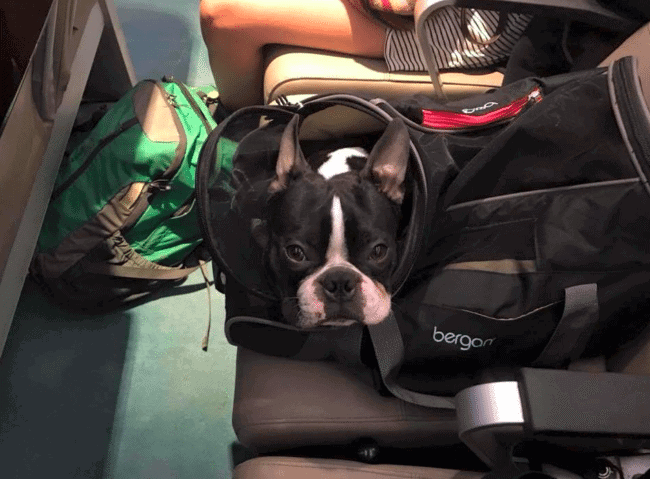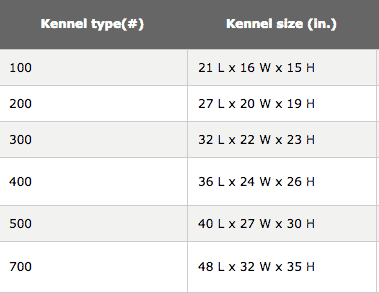MileValue is part of an affiliate sales network and receives compensation for sending traffic to partner sites, such as CreditCards.com. This compensation may impact how and where links appear on this site. This site does not include all financial companies or all available financial offers. Terms apply to American Express benefits and offers. Enrollment may be required for select American Express benefits and offers. Visit americanexpress.com to learn more.
Note: Some of the offers mentioned below may have changed or are no longer be available. You can view current offers here. All values of Membership Rewards are assigned based on the assumption, experience and opinions of the MileValue team and represent an estimate and not an actual value of points. Estimated value is not a fixed value and may not be the typical value enjoyed by card members.
I have an adorable two year old boston terrier named Omar that I share with my boyfriend, pictured below in his carrier on a ferry to Uruguay last year.

My home base is Buenos Aires, but when winter strikes come June we escape to Northern hemisphere summer to enjoy warmer temps and time with family and friends around the United States. Sometimes we also fly back for Christmas, like we did a week ago. Within the last year we started bringing our four legged furry companion in the cabin on these pilgrimages, as he’s right at the size and weight to be able to fit in a carrier underneath the seat.
I am writing to you now from outside of Baltimore where the current temperature is below freezing. I half regret leaving balmy Buenos Aires, but when I look at this photo of Omar from Christmas day all my regrets melt away 😀

Before we started traveling with Omar, I did a fair amount of research to explore our options carrying him between continents. I realized there wasn’t much aggregated information about airline policies for traveling with your pet and decided to organize it myself.
Checking a myriad of sources is a pain. Hopefully the information in this post will equip you with the knowledge to plan more travel with your fur baby. Below I’m going to cover policies of the three major American carriers. Perhaps at a later date I will write a Part II, covering other popular American and foreign carriers.
All policies detailed are regarding travel with normal pets, not service animals.
Rules That Generally Apply to All Airlines Listed Below
- Dogs must be able to stand up, turn around, and lie down in their kennel
- The amount of pets allowed on flights is capacity controlled, so before booking your ticket or award make sure to call the carrier you will be flying first to see if there’s room.
- Most airlines don’t allow brachycephalic (aka snub-nosed) dogs or cats as checked luggage or cargo. Exceptions are noted in each airline’s section
- The following excerpt is from united.com but applies to all pets entering the United States:
- The Centers for Disease Control and Prevention (CDC) require all dogs entering the U.S., except those arriving from certain rabies-free countries, to be immunized against rabies. Vaccinations must be completed at least 30 days before arrival in the U.S. Since puppies must not be vaccinated before three months of age, puppies under four months old will not be admitted into the U.S. unless they are arriving from a rabies-free country. Each dog entering the U.S. must be accompanied by a valid certificate of rabies vaccination, signed by a licensed veterinarian and including the following information:
- Name and address of the dog’s owner
- Identifying information for the dog, including breed, sex, age, color and markings
- Date of vaccination and the name of the vaccine used
- Date when the vaccination expires. If no expiration date is stated, the vaccination must have been completed within 12 months before arrival in the U.S.
- The Centers for Disease Control and Prevention (CDC) require all dogs entering the U.S., except those arriving from certain rabies-free countries, to be immunized against rabies. Vaccinations must be completed at least 30 days before arrival in the U.S. Since puppies must not be vaccinated before three months of age, puppies under four months old will not be admitted into the U.S. unless they are arriving from a rabies-free country. Each dog entering the U.S. must be accompanied by a valid certificate of rabies vaccination, signed by a licensed veterinarian and including the following information:
- As far as health certificates/requirements for traveling outside the United States, you’ll need to check your destination country’s policy
- As far as health certificates/requirements for traveling domestically, I’m pretty sure that varies from state to state. Let us know in the comments if you have any experience in that arena.
Carry On VS. Checked Luggage VS. Cargo
Before getting into each major airline’s policies, I want to explain what the difference is between taking your pet as carry on, checked luggage, or shipping them as cargo– at least from what I gather.
Carry on: You take your pet in a kennel in the cabin of the airplane with you.
Checked Luggage: Your pet travels underneath the plane (in the same general conditions as cargo), the main difference from cargo being that you are on the same plane.
Cargo: Your pet travels underneath the plane (in the same general conditions as checked luggage) but you do not have to be present on the plane.
American Airlines
You have three options for traveling with your pet on American Airlines. You can bring them in the cabin if they’re small enough, check them, or ship them as cargo.

Carry On
- Personally you’re allowed to carry on one kennel.
- American Airlines flights can have a maximum of seven kennels on each (not including service animals).
- On American Eagle flights, five kennels are allowed (with only one allowed in First Class).
- Non-collapsible kennels must be no larger than 19 inches x 13 inches x 9 inches.
- Soft-sided collapsible kennels can be larger if they’re made of water-repellant material, are padded or have nylon mesh ventilation on two or more sides, and totally fit under the seat in front of you.
- Within and between the United States and Canada, Mexico, Central America, Colombia and the Caribbean (based on specific country’s entry policy), the cost is $125 per kennel.
Checked Luggage
- Personally you’re allowed to check two kennels.
- Kennel cannot be collapsible.
- No brachycephalic (aka snub-nosed) dogs or cats can be checked. Read this page to see a list of examples.
- Maximum dimensions on kennels: up to 40 inches x 27 inches x 30 inches. Series 500 is the largest acceptable, except on the Boeing 737, the McDonnell Douglas MD-80 (S80), or American Eagle airplanes. Kennels checked on an MD-80 must be able to fit through the cargo door whilst in an upright position.)
- Checked pets cannot travel on A321S, A321H, A320, A319 aircraft and all flights operated by regional partner Air Wisconsin.
- Within and between the United States and Canada, Mexico, Central and South America and the Caribbean, the cost is $200 per kennel.
- American Airlines doesn’t recommend sedating your pet, but if you do, you’ll need to give an agent the name of the medication, the amount and date and time the animal took it.
Pets younger than eight weeks are not permitted to travel on American Airlines.
Read American Airlines’ Cargo Animals page for detailed information on shipping your dog as cargo.
Your pet cannot travel if the forecasted temperature is above 85 degrees F or below 45 degrees F at any location on the itinerary. Cold temperature restrictions can be waived with a letter from your vet as long as forecasted temperatures is above 20 degrees F.
Read American Airlines’ Traveling With Pets page for more specific details on kennel requirements, breed restrictions, destination restrictions, and restrictions on flights with connections.
United
You have two options for traveling with your pet on United. You can bring one in the cabin if it’s small enough or ship it via PetSafe®.
Carry On
- Personally you’re allowed one kennel as carry on.
- Four pets per flight are allowed in United Economy® on all United flights.
- Two pets per flight are allowed in our premium cabins on select aircraft. Pets are not permitted in premium cabins on Boeing 747, 757, 767, 777 or 787 aircraft.
- You cannot be seated in the bulkhead or an emergency exit row with a pet.
- If traveling with a pet in economy on a Boeing 757-200 aircraft, you have to have a window seat.
- Non-collapsible kennels must be no larger than 17.5 inches x 12 inches x 7.5 inches.
- Soft-sided collapsible kennels can be larger (recommended maximum of 18 inches x 11 inches x 11 inches) as long as it will fit under the seat in front of you.
- Cost: $125 each way for flights within the United States.
There’s not other information on United’s site about traveling with your in-cabin pet internationally other than the restriction of pets on flights to, from, or through Australia, Hawaii, or Micronesia (including Guam, a United hub). You’ll have to call United Customer Service at 1-800-864-8331 to learn more.
PetSafe® (Checked Luggage)
For dogs that are too big to fit in the cabin, you can ship them via United’s PetSafe.

- Kennel cannot be collapsible.
- United does allow you to send most brachycephalic (snub-nosed) dogs and cats via PetSafe, but they do have their own set of policies listed here.
- English Bulldogs, French Bulldogs, Olde English Bulldogs, Shorty Bulls/Bulldogs or mixes of these breeds that are more than six months old or 20 pounds are the exception– they are not allowed.
- American Bulldogs, Boston Terriers, Pugs and mixes of these breeds are OK, but you must follow these regulations:
- May 15 – September 15: None will be accepted.
- September 16 – May 14: These animals will be accepted as long as the forecasted temperatures along the itinerary are expected to be no higher than 85°F at the time when the animal’s flights are scheduled to arrive and depart. Animals with connecting flights may also be kenneled during the day to avoid the heat.
- Check this pdf to see how much it will cost to send your pet via PetSafe.
- Here is a chart of kennel types that are accepted:

- All of the above kennel types are allowed on all types of United planes except:
- the 700 series, which is not accepted on Boeing 737 aircraft
- Embraer Regional Jets (ERJ and SRJ) operated by ExpressJet Airlines don’t accept any animals
- Fun fact: you’ll earn 500 United miles for every pet you send via PetSafe domestically, and 1,000 United miles for every pet you send internationally.
Pets younger than eight weeks are not permitted to travel on United.
More specific details can be found here regarding destination restrictions when shipping your pet via PetSafe.
More specific details can be found here regarding kennel requirements when shipping your pet via PetSafe.
Delta
You have two options for traveling with your pet on Delta. If it’s small enough you can bring one in the cabin, and if not you can ship it via VARIATION® LIVE (Delta’s brand for animal cargo).
Carry On
- Personally you can only carry on one kennel.
- Delta flights can have a maximum of two kennels in First Class, two kennels in domestic Business or domestic Delta One, and four in economy.
- No kennels are allowed in international Business Class or Delta One.
- On American Eagle flights, five kennels are allowed (with only one allowed in First Class).
- Delta doesn’t list the maximum kennel sizes for carry on, you have to call Delta Reservations about your specific plane to find out. The kennel must be able to fit under the seat in front of you.
- Pet must be at least 10 weeks old for domestic travel, 16 weeks if traveling from other countries to the United States, and 15 weeks for European Union travel.
- One way fees for traveling with your pets to/from the following locations:
- U.S./Canada: $125 USD/CAD
- Virgin Islands: $125 USD/CAD
- Puerto Rico: $125 USD/CAD
- Outside the U.S.: $200 USD/CAD/EUR
- Brazil: $75 USD
Cargo
- Kennel cannot be collapsible.
- Pets under eight weeks of age cannot be shipped as cargo.
- Temperature restrictions (see a list of examples of brachycephalic breeds):

- American, English (including the Old English) or French bulldogs are not allowed to be shipped as cargo under any condition.
- Delta doesn’t define the accepted dimensions of kennels, apart from: “You must use a kennel that meets USDA and IATA LAR regulations”.
- Look up the cost of shipping your warm-blooded pet as cargo here.
- If you choose to sedate your pet you’ll need to attach a note from the veterinarian on the kennel.
Read Delta’s cargo page for more specific details about shipping your dog via VARIATION® LIVE.
Bottom Line
If you collect miles and points to travel and also want to take your pet along, it’s wise to familiarize yourself with the major airlines’ policies as that could very well affect the kind of miles you should be collecting.
For example, American Airlines doesn’t allow travel with pets as carry on luggage between Argentina and the United States (a trip I take often), and my dog is snub-nosed, therefore he cannot travel as checked luggage nor as cargo on their planes. Delta actually doesn’t allow pets in the cabin flying between Argentina and the United States either, so if I wanted miles for another future trip to take Omar home, then I shouldn’t focus on one world Alliance nor Skyteam miles. Instead, I focus on collecting Star Alliance miles to book United flights.
Bookmark this page in case you plan on traveling with your fur baby in the future.


[…] And here’s the big reason: I’m taking my dog. United is one of the only pet friendly options that allows me to travel with my boston terrier in the cabin to the United States from Argentina (pictured above). Got a little buddy you want to bring along too? Read more pet policies in Airline Regulations for Traveling With Your Pet. […]
I have never seen a better article on this issue ANYwhere. For that matter, I have never seen a more thorough and detailed discussion of a flying/travel issue on any travel/flying website other than the occasional ones on “miles” sites which are instructional, taking a flyer from A to Z on a specific miles topic. Thanks for all this detailed information!
I am completely against bringing animals on airplanes. Having had asthma my entire life of 72 years, this is the WORST thing that could possibly happen to the millions of allergy-plauged travelers– except maybe blowing dust and animal dander throughout the plane. Get a grip people. What is more important– having your fifi dog next to you for comfort? or not dying of asphyxiation from bronchial constriction? I have spent the better part of my life as a clinical herbalist trying to help people recover from exposure to animals. Sorry, but this is just not right.
Amen! I’m a mess after flying next to someone’s dog. If it’s a true (and I mean REAL) service dog, I’ll suffer for the sake of the person needing him. But not for someone’s pet they can’t be parted from. FYI – I have seen dozens of incidents of dogs taking poops and peeing on the carpet in airplane terminals.
I’m moving across country and don’t have a choice because of temperatures but to bring our cats on the plane. Stewardess told me on last flight I took that yes you can buy a seat for your pet. I tried doing this but am told I have to have a person in that seat. Do you know? For the allergy sufferers I understand. I had planned on driving across country for the move but I broke my right knee cap and tore up the knee pretty badly. I’m sorry.
I assume that you just put them in their carrier under the seat in front of you, no need to buy them an actual ticket. You will have to pay a fee though to carry them on.
Sara thank you so much for this info
Really helpful
I am returning to my country Argentina with my Boston and I am really concern about her safety
This post has give me more reassurance than we can make it
Thanks a lot!!
You’re welcome! Do you live in Buenos Aires? We should hang out together with our Bostons 🙂
Definitely!!! Send me an email ! Will be arriving in October
Great! I’m in the US right now but should be back in BA in late October. Will reach out!
Sarah a question, how your dog deals with so long flight from BA to the USA. I will travel from
Europe and will be long as well. Where can I reach you for further advice? Thanks!!!!
We are just lucky, Omar is very calm and sleeps the whole time. Probably best to ask a vet for a sedative if your dog is prone to anxiety. I’ll email you!